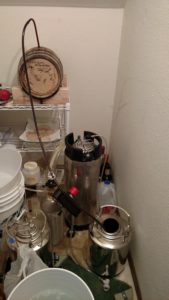After two weeks in the barrel, the first fill is complete! I now have a 2.5-gallon keg full of bourbon barrel aged Russian imperial stout. That is currently carbonating in the keezer and getting ready to enjoy. I intend to bottle some of it, but I have not decided the ratio of keg to bottle that I want to have quite yet.
With the small barrel volume I wanted to be careful not to leave the beer in the barrel too long. I checked the beer every 3-4 days to check the flavor and aroma of the beer. After 3 days the aroma was already very strong. Bourbon character jumped out of the glass. The barrel character was barely perceptible in the flavor so it remained in the barrel. The aroma remained strong and the flavor slowly developed over the 2 weeks the beer stayed in the barrel. I feel good about the final beer result.
Since it seems that I cannot have anything go 100% smoothly when it comes to brewing I did have some drama at the end of the first aging. First was that I when I went to pull what would turn out to be the final sample the airlock was bubbling. Not exactly what you want to see when you are trying to age completely fermented beer. The second is that when I decided to pull the stout from the barrel I could not get a siphon started.
Let’s start with the siphon. Clearly from the picture above I was able to solve this one. The bunghole in the barrel is narrow. My autosiphon does not fit through the hole so I needed to just use a racking cane. I was trying to start the siphon with a sanitized turkey baster, but I could only get the beer to the top of the racking can before I ran out of suction from the baster. I ran out of time to fix this and the beer ended up sitting in the barrel for an extra day. I ended up just cutting about 6 inches off of the racking cane with a hacksaw and then I was able to easily start the siphon and get the beer out of the barrel.
So now on to the potential bigger issue: the bubbling airlock. I can only think of two things that could cause the airlock to bubble. The first is fluctuating temperature that is causing the pressure inside the barrel to change. The second is that fermentation has started again. Obviously of the two options the first is what I’m hoping happened. We have had some large temperature swings lately and a large change on the day I saw the airlock bubble. If fermentation started again then I likely have an infected barrel.
So if the barrel is infected what are my options to move forward from this batch? That question essentially paralyzed me for a couple hours. I saw four paths in front of me:
- Fill the barrel with the remaining imperial stout.
- Fill the barrel with the remaining imperial stout and add a sour culture.
- Brew a beer with the intention of making a sour beer to put in the barrel.
- Dispose of the barrel.
I am a homebrewer with my first barrel. I view this as a learning experience so I immediately removed option four. Sure I could waste some beer if I don’t get anything quality out of the barrel, but that’s ok. I’ll learn from it and do better if I ever get another barrel.
The next decision is whether I intentionally sour the barrel now or not, option 1 vs option 2/3. The plan for the barrel was to be soured when it becomes neutral or has diminished character. However, I assumed I would be able to put at least 2-3 batches through it before this happened. I think if I intentionally sour a potentially contaminated barrel that the culture I add would take over in the barrel. Seeing this Mad Fermentationist post about his Sour Bourbon Barrel Porter made me fee better about just going for it and souring the barrel. A beer like that is doable and designing a beer specifically for souring is obviously a solid contender. Intentionally souring the barrel seems like the safest route if in fact the barrel is contaminated, but that is still the big if.
What if there is nothing wrong with the barrel? What if I could have more delicious bourbon barrel aged stout? The current beer is not showing any signs of contamination, but it has only been a couple weeks and it is a strong flavored beer. The next batch of stout will be in there even longer to get the desired barrel character. Plenty of time for an infection to take over if the issue is present.
Despite souring the barrel now probably being the safest route, I decided to just stay the course. I want to get more clean bourbon barrel stout if I can. If I can’t then I’ll learn something from it. I can always add a sour culture to the barrel, but there is no coming back from that.
The barrel is currently filled with more stout. I’ll start checking it in 2-3 weeks to see how its doing. I’m currently excited and a little anxious for the next step in my barrel journey, but I’m confident that no matter how this batch turns out I’ll get something positive from the experience.
